In the realm of unique wildlife, few creatures capture the imagination quite like the Savanna Nightjar. With its mesmerizing behavior and specialized adaptations, this captivating bird stands out as a marvel of the avian world.
Thriving in the darkness of the night, these nocturnal marvels have mastered life in the diverse habitats of Asia. Their cryptic plumage shields against the harsh realities of the savannas and open forests they inhabit, allowing them to blend into their surroundings seamlessly.
Yet, it’s not just their camouflage that sets them apart; their enchanting nighttime serenades echo through the tranquil landscapes, adding an aura of mystique to their presence.
As we embark on a journey to unravel the mysteries of the Savanna Nightjar, we’ll uncover their captivating allure and vital role as integral members of our global ecosystem.
Physical Characteristics of the Savanna Nightjar
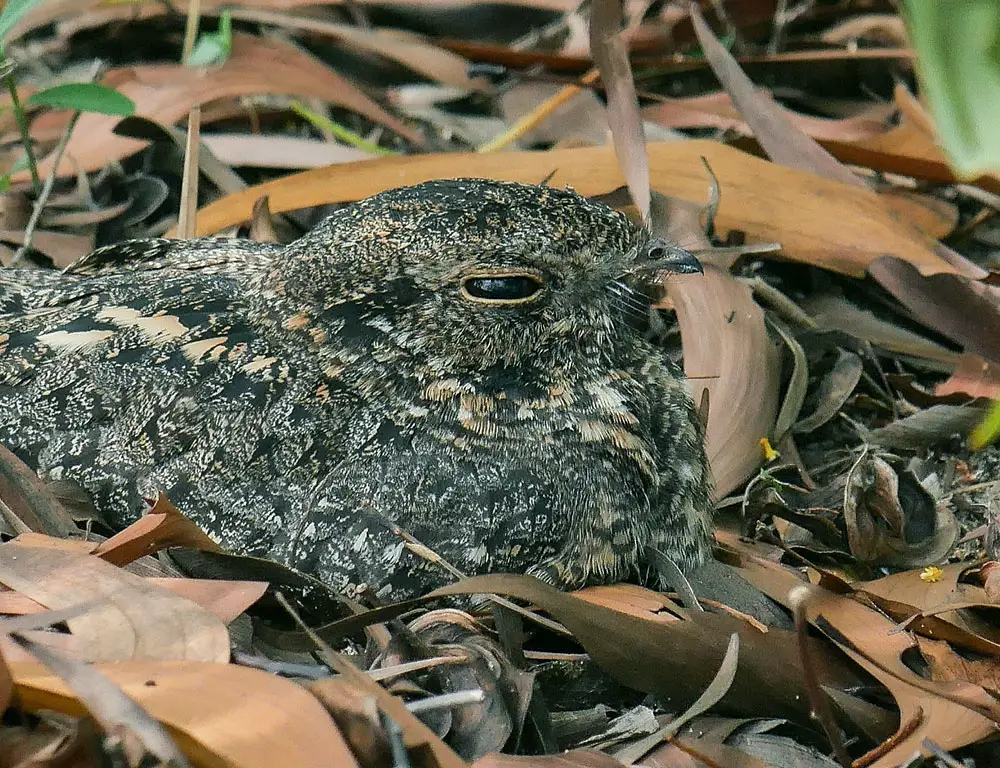
The Savanna Nightjar (Caprimulgus affinis) possesses various physical characteristics that contribute to its intriguing nature and ability to thrive in its habitat.
Here’s a closer look at some of these features:
Plumage
The bird’s cryptic plumage consists mainly of gray-brown feathers adorned with intricate patterns of black and buff streaks and spots. This coloring helps blend seamlessly into its savannah habitat, providing effective camouflage.
Eyes
Savanna Nightjars have huge eyes, a common trait among nocturnal birds. These eyes are designed to maximize light intake, aiding in navigation and hunting during moonlit nights.
Wings
The nightjar’s wings are notable for being long and pointed, facilitating swift and agile flights. They can span anywhere from 21 to 24 cm when fully spread, providing efficient aerodynamics during flight.
Size and Weight
Savanna Nightjars are relatively lightweight birds. On average, males weigh around 50 grams, while females are slightly heavier at approximately 55 grams.
Beak
The bird’s beak is short yet wide gaping, ideal for capturing insects mid-flight. This specialized beak structure enables efficient feeding on the wing, a crucial adaptation for a primarily insectivorous species.
Habitat and Distribution of the Savanna Nightjar
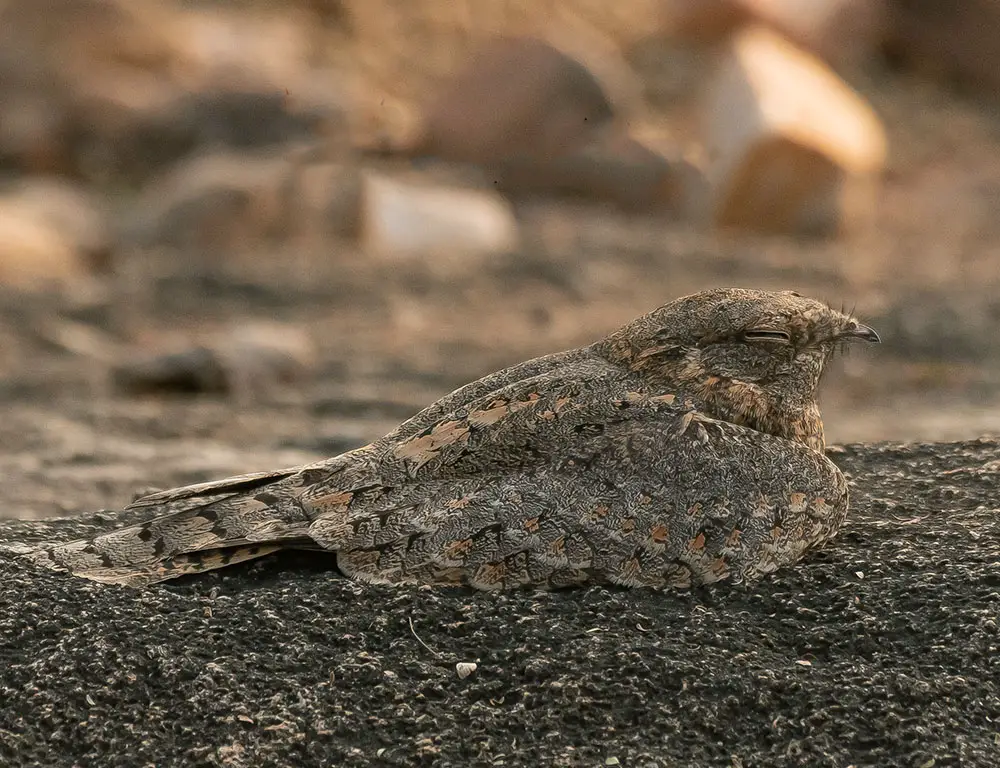
The Savanna Nightjar (Caprimulgus affinis) exhibits remarkable adaptability to various habitats across its wide distribution range.
Here’s an overview of its habitat preferences and distribution:
Habitat
- Open Habitats: Savanna Nightjars prefer open habitats such as dry savannas and grasslands where vegetation is sparse. These environments provide suitable roosting spots on the ground during daylight hours.
- Sandy Beaches: Besides savannas and grasslands, Savanna Nightjars can also be found in sandy beach habitats, particularly those with sparse vegetation.
- Urban Environments: Interestingly, these nightjars display a notable ability to adapt to urbanization. They are known to nest in city parks or along roadsides, indicating a tolerance for human presence and modified landscapes.
Distribution
- Southeast Asia: The Savanna Nightjar is widespread across Southeast Asia, including countries such as India, Sri Lanka, China, and Indonesia. It is commonly found in various habitats within this region.
- Middle East: Some populations of Savanna Nightjars have been observed in the Middle East, specifically in countries like Oman and the United Arab Emirates. This indicates a broader distribution range extending beyond Southeast Asia.
Nocturnal Behavior
As nocturnal birds, Savanna Nightjars are most active at dusk and night. During this time, they emit distinct calls while hunting insects under darkness, showcasing their specialized adaptations for nighttime foraging.
Behavior and Diet of Savanna Nightjars
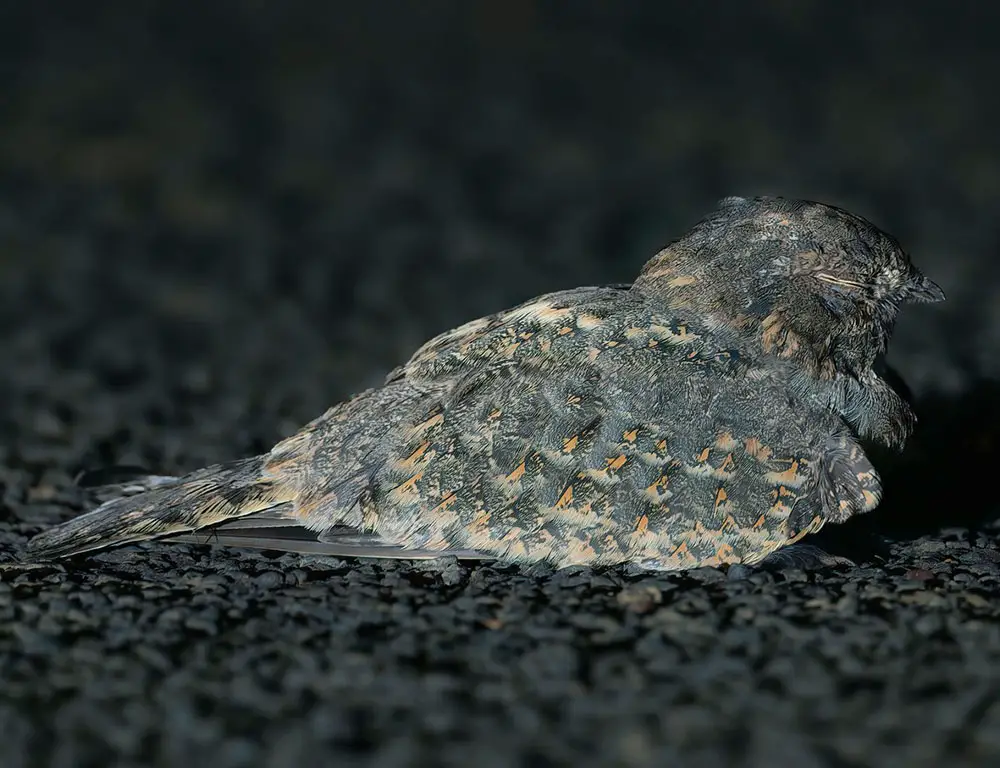
Savanna Nightjars are fascinating creatures with unique behaviors and dietary preferences worth exploring.
Let’s delve deeper into their behavior and diet:
Behavior
- Crepuscular Activity: Savanna Nightjars are primarily crepuscular, meaning they are most active during twilight periods, particularly just after sunset and before sunrise. While they may exhibit some nocturnal activity, dusk and dawn are their prime times for hunting and other behaviors.
- Nocturnal Activity: While crepuscular periods are prime activity times, Savanna Nightjars may exhibit nocturnal behavior, especially during moonlit nights when visibility is relatively better.
- Vocalization: The distinctive calls of Savanna Nightjars are a notable aspect of their behavior. Their repetitive ‘chunk-chunk-chunk’ calls serve various purposes, including territorial defense, mate attraction, and communication with other nightjars.
- Nesting Behavior: Unlike many bird species, Savanna Nightjars do not build nests. Instead, they lay their eggs directly on the bare ground. Their excellent camouflage skills facilitate This unique nesting strategy, which helps conceal the eggs from predators.
Diet
- Insectivorous Diet: Savanna Nightjars primarily feed on insects, including mosquitoes, beetles, termites, and other flying or crawling insects. Their diet is rich in protein obtained from these insects.
- Feeding Technique: They employ a hunting technique known as ‘hawking,’ where they fly out from a perch and catch prey mid-air. This aerial feeding strategy requires precision and agility, which Savanna Nightjars have developed to perfection.
- Adaptation to Habitat: Their diet of insects reflects their adaptation to the savanna habitat, where insects are abundant, especially during twilight and nighttime hours.
Reproduction and Life Cycle of Savanna Nightjars
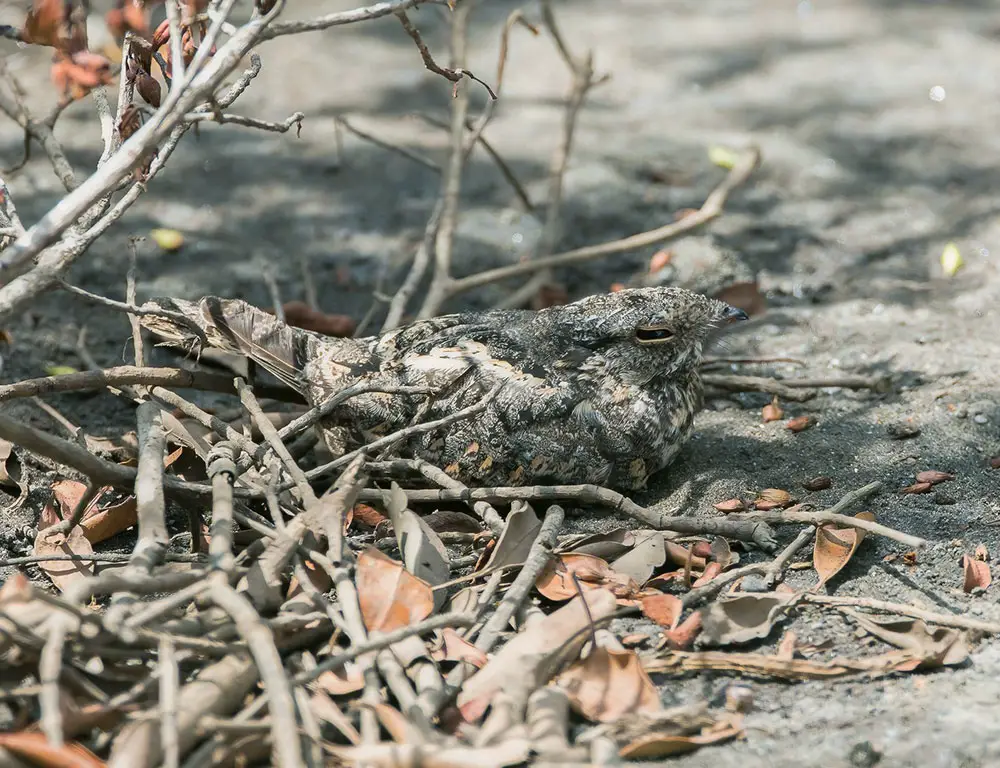
The Savanna Nightjar’s reproduction and life cycle indeed showcase fascinating adaptations to their environment and behavioral patterns. Here’s a summarized overview:
Breeding Season
April marks the beginning of the breeding season for Savanna Nightjars, with peak activity occurring in May and June. This timeframe coincides with favorable environmental conditions for nesting and rearing young.
Courtship Display
Male Savanna Nightjars engage in elaborate aerial acrobatics to attract females during the breeding season. These displays serve to demonstrate the male’s fitness and prowess as a potential mate.
Egg Laying
Female Savanna Nightjars typically lay their eggs directly on bare ground or leaf litter, without constructing conventional nests. This unique approach may be an adaptation to their habitat, allowing them to blend seamlessly with their surroundings.
Clutch Size
Savanna Nightjar females lay a relatively small clutch of only two eggs at a time. This limited clutch size may be advantageous in environments where resources are scarce or unpredictable, allowing parents to allocate more attention and resources to each individual offspring.
Egg Appearance
The eggs of Savanna Nightjars are cryptically colored with mottled brown and gray patterns, providing camouflage against the ground cover. This adaptation helps protect the eggs from predators by making them difficult to detect.
Incubation
Both male and female Savanna Nightjars are responsible for incubating the eggs, which lasts approximately 17-18 days.
This cooperative breeding behavior may enhance the chances of reproductive success by ensuring constant protection and warmth for the developing embryos.
Chick Development
Upon hatching, Savanna Nightjar chicks are semi-precocial, covered in downy feathers that blend with their surroundings. This camouflage helps protect them from predators during the vulnerable early stages of development.
Fledging
It takes about three weeks for Savanna Nightjar chicks to fledge, during which time they continue to receive parental care and guidance. Once fledged, they gradually gain independence but may still rely on parental assistance for some time.
Conservation Status of the Savanna Nightjar
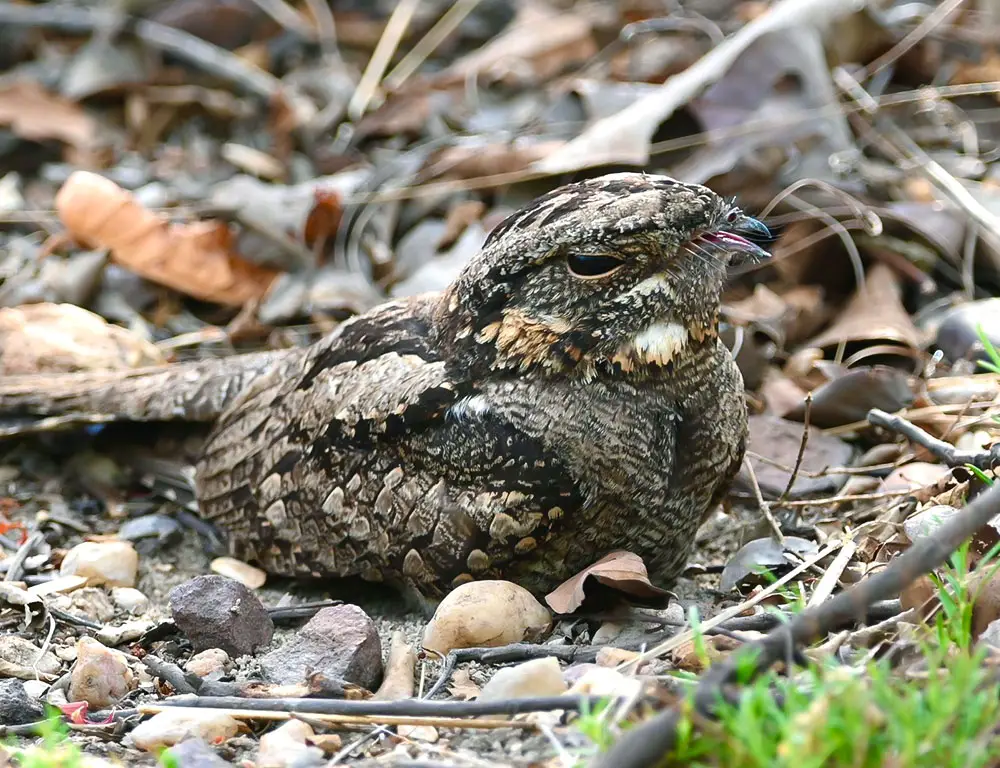
The Savanna Nightjar, currently listed as a species of “Least Concern” by the International Union for Conservation of Nature (IUCN), faces threats primarily due to habitat loss, a consequence of human activities such as urban development and agricultural expansion.
While it isn’t immediately threatened with extinction, ongoing habitat destruction poses a significant risk to its long-term survival.
Here’s a closer look at its conservation status and the challenges it faces:
Habitat Loss
Urbanization, agriculture, and other human activities have resulted in the degradation and loss of the Savanna Nightjar’s natural habitat. This habitat loss not only displaces the birds but also diminishes their food resources, impacting their ability to thrive and reproduce.
Global Trends
Statistics indicate alarming trends in habitat loss, with approximately 50% of wetlands in Asia disappearing over the past century, and over 1 million square miles of wilderness area lost globally since 1990.
These trends highlight the urgent need for conservation efforts to mitigate further habitat destruction.
Conservation Efforts
Conservation initiatives aimed at preserving and restoring natural habitats are crucial for safeguarding populations of Savanna Nightjars and other wildlife species.
These efforts include local projects focused on habitat preservation and larger-scale endeavors addressing issues like climate change and promoting sustainable land use practices.
Education and Awareness
Educating communities about the importance of preserving biodiversity and the role of species like the Savanna Nightjar in maintaining balanced ecosystems is essential for fostering a sense of stewardship towards the environment.
Raising awareness and promoting conservation education can inspire collective action to protect vulnerable species and their habitats.
Conclusion
The Savanna Nightjar emerges as a captivating subject of study, revealing a world of unique behaviors and adaptations contributing to its success in challenging environments.
Despite its elusive nature and nocturnal habits, this bird’s resilience and remarkable camouflage capabilities highlight its significance in avian biodiversity
Through patience and a keen eye, we uncover the secrets of its crepuscular lifestyle, ground nesting tendencies, and mastery of survival in the savannah. As wildlife enthusiasts or casual observers, we’re drawn to its ability to thrive amidst adversity and its undeniable beauty.
The Savanna Nightjar serves as a compelling reminder of nature’s complexity and diversity, igniting curiosity and appreciation for the wonders that await discovery in the natural world.